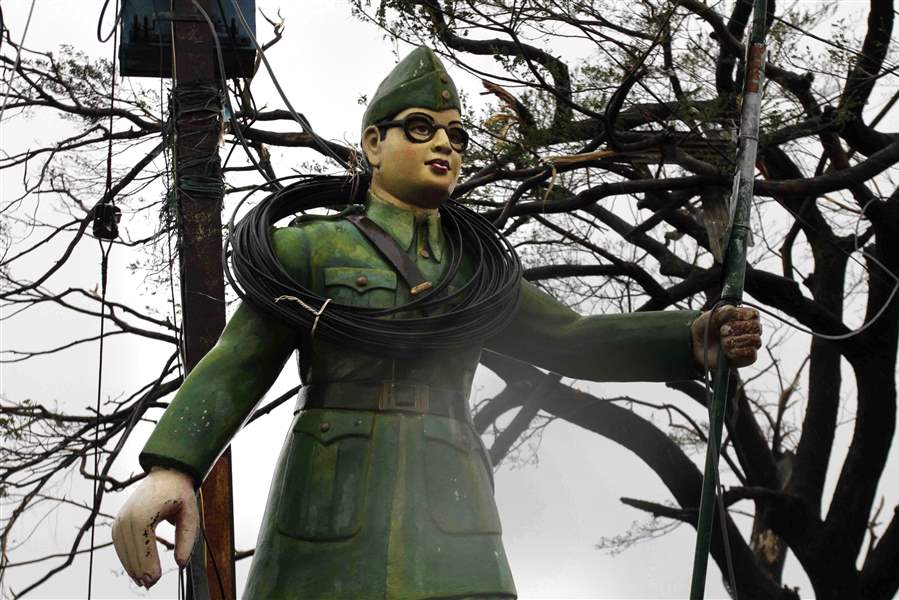
Massive Indian cyclone weakens after landfall; officials say few lives lost
10/13/2013
Electric wires are entangled around a statue of Indian freedom fighter Subhash Chandra Bose at road crossing during Cyclone Phailin in Berhampur, India, Sunday, Oct. 13, 2013. An immense, powerful cyclone that lashed the Indian coast, forcing 500,000 people to evacuate and causing widespread damage, weakened Sunday after making landfall. Several people died in the rains that fell ahead of the storm, most killed by falling branches, Indian media reported, but the situation on the ground in many areas was still unclear after Cyclone Phailin slammed into the coast Saturday evening in Orissa state, where power and communications lines were down along much of the coastline. (AP Photo/Bikas Das)
ASSOCIATED PRESS
BEHRAMPUR, India — India began sorting through miles of wreckage today after Cyclone Phailin roared ashore, flooding towns and villages and destroying tens of thousands of thatch homes, but officials said massive evacuation efforts had spared the east coast from widespread loss of life.
The storm, the strongest to hit India in more than a decade, destroyed hundreds of millions of dollars’ worth of crops, but more than 18 hours after it made landfall in Orissa state, officials said they knew of only nine fatalities.
The final death toll will almost certainly climb, and parts of the cyclone-battered coast remain isolated by downed communication links and blocked roads, but the evacuation of nearly 1 million people appeared to have saved many lives.
“Damage to property is extensive,” said Amitabh Thakur, the top police officer in the Orissa district worst-hit by the cyclone. “But few lives have been lost,” he said, crediting the mass evacuations.
A cargo ship carrying iron ore, the MV Bingo, sank Saturday as the cyclone barreled through the Bay of Bengal, coast guard officials said. The crew of 18 — including 17 Chinese and one Indonesian — got into a lifeboat but had not been located by midday today.
Port officials were in touch with the crew by radio until 4 a.m. today, and the coast guard was still searching for the crew, said guard Commandant Sharad Matri.
The storm weakened significantly after making landfall early Saturday night, with some areas reporting little more than breezy drizzles today, but meteorologists said parts of the region would face heavy rains and winds for the next 24 hours.
“Its intensity is still strong, but after crossing the coast it has weakened considerably,” Sharat Sahu, a top official with the Indian Meteorological Dept. in Orissa, told reporters.
Indian officials spoke dismissively of American forecasters who had warned of a record-breaking cyclone that would drive a massive wall of water — perhaps as large as 9 meters high (30 feet high) — into the coastline.
“They have been issuing warnings and we have been contradicting them,” said L.S. Rathore, director-general of the Indian Meteorological Department. “That is all that I want to say.”
“As a scientist, we have our own opinion and we stuck to that. We told them that is what is required as a national weather service — to keep people informed with the reality without being influenced by over-warning,” he said at a news conference in New Delhi, the capital.
The Indian government had faced immense public criticism after its slow response to a series of deadly floods and mudslides in June in the northern state of Uttarakhand, where more than 6,000 people were killed.
But officials took few chances with Phailin, especially given memories of a 1999 Orissa cyclone that devastated the coastline and left at least 10,000 people dead.
Nearly 1 million people were evacuated from the coast ahead of the storm, including more than 870,000 in Orissa and more than 100,000 in neighboring Andhra Pradesh.
Officials in both states had been stockpiling emergency food supplies and setting up shelters. The Indian military put some of its forces on alert, with trucks, transport planes and helicopters at the ready for relief operations.
Electric utility authorities in Orissa switched off the power in 12 districts in the path of the cyclone after scores of electric pylons toppled from the torrential rain and high winds.
The storm wreaked havoc in Behrampur, a small town about 10 kilometers (7 miles) inland from where the eye of the cyclone struck, with the wind shattering windows, blowing down trees and electrical poles, and terrifying residents. But only three people died in the town, a security official said.
“The trees and the buildings could not be saved, but the people have been evacuated, so the human toll was contained so far,” said Naresh Sharma, a commander with the Indian Central Reserve Police Force.
For the people living along the coast, many of whom live as subsistence farmers in mud-and-thatch huts, the economic toll will be immense.
Heavy rains and surging seawater destroyed more than 500,000 hectares (1.23 million acres) of crops worth an estimated 24 billion rupees ($395 million), according to Orissa’s disaster minister, S.N. Patro.
With some of the world’s warmest waters, the Indian Ocean is considered a cyclone hot spot, and some of the deadliest storms in recent history have come through the Bay of Bengal, including the 1999 cyclone.
U.S. forecasters had repeatedly warned that Phailin would be immense, and as the cyclone swept across the Bay of Bengal toward the Indian coast Saturday, satellite images showed its spinning tails covering an area larger than France.